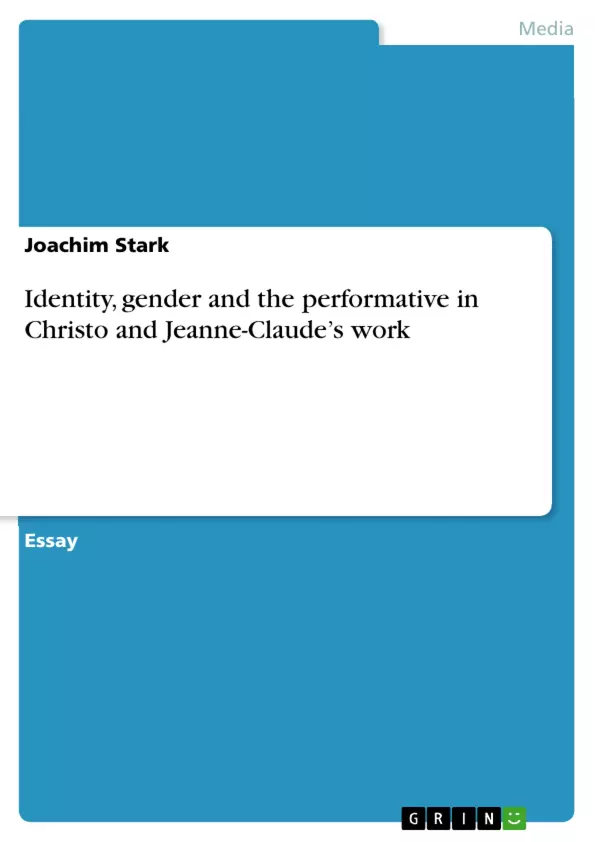This essay tries to point out that Christo and Jeanne-Claude’s work deals with concepts of identity, gender and the performative, ideas which inform a great deal of the art that has been produced since the 1960s. These aspects in the work of the two artists have generally been overlooked due perhaps to the giganticism of many of their projects realized since the end of the 1960s, like “Wrapped Coast” (1968/69, Australia), “Valley Curtain” (1970/72 USA), “Surrounded Islands” (1980-83 USA), “Pont Neuf Wrapped” (1975/85, France), “Wrapped Reichstag” (1971-1995 Germany), or “The Gates” (2005 USA). Questions of identity, gender, and performance have not really been adressed in interpretations of Chisto and Jeanne-Claude's work. But at least since 2002 there are statements by Christo himself, which make clear that identity and gender have indeed been on his mind and that there also was quite early a link to Dada and Surrealism. In this respect it is certainly relevant that in 1963 Christo met Marcel Duchamp, who until 1968, the year of Duchamp’s death, remained a friend and supporter. Christo's wrappings imply the blurring of identities, they transform male forms into feminine forms, or even try to introduce the impression of the formless, a concept developed by George Bataille. The performative points in the same direction. The concept of performance will have to be modified and enlarged in the case of Christo and Jeanne-Claude, as ther performances are not bound to a specific time and location, for instance in a gallery or a theatre. The performances often extend over several years or even decades and imply the presence of the artists at numerous different locations. Here the aspect of politics comes into view. As their environmental installations involve public buildings and /or public spaces and often extend over huge distances , a considerable number of different interests (for instance those of the political authorities, private landowners, pressure groups, the media) have to be taken into account. Thus, political processes serve the aim of realizing a work of art, and not the other way round.
Inhaltsverzeichnis (Table of Contents)
- Introduction
- Questions of Identity.
- Aspects of Gender
- The performative in the art Christo and Jeanne Claude......
- Conclusion:.
Zielsetzung und Themenschwerpunkte (Objectives and Key Themes)
This essay aims to explore the concepts of identity, gender, and the performative in the work of Christo and Jeanne-Claude. It argues that these ideas are central to their artistic practice, particularly in light of the monumental scale of their projects since the 1960s.
- The role of identity and gender in Christo and Jeanne-Claude's work
- The performative aspect of their art, particularly in relation to the wrapping of objects and spaces
- The influence of Dadaism and Surrealism on their artistic practice
- The relationship between Christo and Jeanne-Claude's art and the consumer society
- The political dimension of their work, including its potential to challenge masculine authority and the fetishization of the female body
Zusammenfassung der Kapitel (Chapter Summaries)
- Introduction: This chapter introduces the essay's focus on exploring the concepts of identity, gender, and the performative in Christo and Jeanne-Claude's work. It highlights the significance of these ideas in the context of contemporary art, particularly since the 1960s. The chapter also provides a brief overview of some of the artist's major projects, highlighting their scale and impact.
- Questions of Identity: This chapter delves into the concept of identity in Christo and Jeanne-Claude's work. It examines how their wrappings can be interpreted as acts of concealing and transforming identity, drawing parallels with Surrealist concepts and artistic practices. The chapter also explores the political implications of these acts, particularly in relation to notions of freedom and control.
- Aspects of Gender: This chapter focuses on the role of gender in Christo and Jeanne-Claude's work. It examines how their art can be seen as a challenge to masculine authority and the fetishization of the female body, through the use of wrapping and the creation of large-scale installations. The chapter also explores the possibility that their work aims to undermine traditional notions of beauty and aesthetics, offering a more subversive perspective.
- The performative in the art Christo and Jeanne Claude......: This chapter dives into the performative aspects of Christo and Jeanne-Claude's art. It examines how their work can be viewed as a series of performances and gestures, highlighting the element of spectacle and the role of the audience in creating meaning. The chapter also explores the relationship between their art and the consumer society, drawing connections to the commodification of art and the creation of spectacle in modern society.
Schlüsselwörter (Keywords)
Key terms and concepts central to the text include: identity, gender, performance, Christo and Jeanne-Claude, Surrealism, Dadaism, Nouveau Réalisme, spectacle, consumer society, political freedom, visual pleasure, and the fetishization of the female body.
- Quote paper
- Joachim Stark (Author), 2006, Identity, gender and the performative in Christo and Jeanne-Claude’s work, Munich, GRIN Verlag, https://www.grin.com/document/160917



